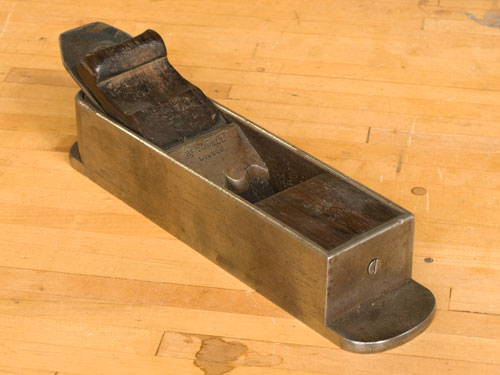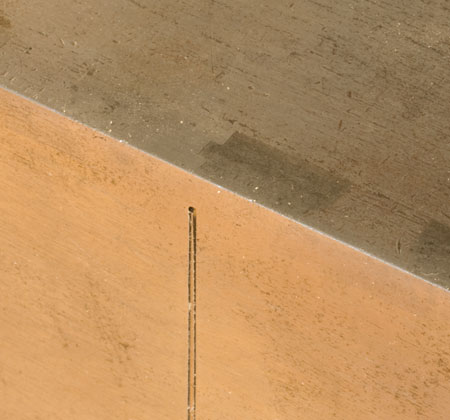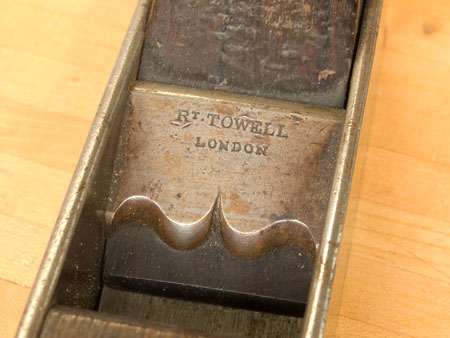 My friend Raney Nelson dropped by the showroom yesterday and asked me to bring in some interesting infill plane. Lately he told me he has been thinking about making a mitre plane and I thought bringing in one might be interesting enough. "Mitre" is the English spelling of "miter", but I always use the English spelling because the mitre plane is a distinctly English phenomena. I own older mitre planes but Towell is considered the first of the full-time English infill makers and he built the first signed infill panel plane that we know of today and probably the first infill rebates planes too. My friend Raney Nelson dropped by the showroom yesterday and asked me to bring in some interesting infill plane. Lately he told me he has been thinking about making a mitre plane and I thought bringing in one might be interesting enough. "Mitre" is the English spelling of "miter", but I always use the English spelling because the mitre plane is a distinctly English phenomena. I own older mitre planes but Towell is considered the first of the full-time English infill makers and he built the first signed infill panel plane that we know of today and probably the first infill rebates planes too.
In general his work always shows elegance and in some cases innovation as infill design struggled to mature, something it finally did in the hands of Steward Spiers the most prominent of the next generation of infill planemakers.
This particular plane has a 2" iron and is fairly typical of mitre planes from before the mid 19th century. The sole is steel and the sides are wrought iron.
The secret to a well performing mitre plane is a very tight mouth both in front of the iron and in back, supporting the iron to the very edge. This is because with a bevel up iron, even if the iron is supported close to the cutting edge, the bending moment of the iron around the body is at a very thin section, at some point at the bevel. In a bevel down plane the bending point of the iron is further along the iron well away from the bevel. (That's why it's easier to make a good bevel down plane than bevel up plane.) In any case comparing pretty good mitre planes to really excellent ones instantly shows the important of a fine mouth behind the iron. of the iron and in back, supporting the iron to the very edge. This is because with a bevel up iron, even if the iron is supported close to the cutting edge, the bending moment of the iron around the body is at a very thin section, at some point at the bevel. In a bevel down plane the bending point of the iron is further along the iron well away from the bevel. (That's why it's easier to make a good bevel down plane than bevel up plane.) In any case comparing pretty good mitre planes to really excellent ones instantly shows the important of a fine mouth behind the iron.
 Towell's mitre planes are constructed just like his contemporaries, with the sole tongue and grooved together around the mouth, and the sides dovetailed in. However one thing I really like about Towell's planes is his most elegant and curvaceous bridge. Towell's mitre planes are constructed just like his contemporaries, with the sole tongue and grooved together around the mouth, and the sides dovetailed in. However one thing I really like about Towell's planes is his most elegant and curvaceous bridge.
Incidentally before you ask, the chances that Towell had any metal working tools other than a few hacksaws, a few metal cutting chisels, a forge, and a lot of files is pretty small. This plane was done all by hand.
I'm guessing that this plane is fairly early in his career, and of all the types of planes Towell made, the mitre plane is the most common. It's also the earliest form of infill that existed and the jumping off point for Towell and other innovators. |
 Joel's Blog
Joel's Blog Built-It Blog
Built-It Blog Video Roundup
Video Roundup Classes & Events
Classes & Events Work Magazine
Work Magazine


 My friend Raney Nelson dropped by the showroom yesterday and asked me to bring in some interesting infill plane. Lately he told me he has been thinking about making a mitre plane and I thought bringing in one might be interesting enough. "Mitre" is the English spelling of "miter", but I always use the English spelling because the mitre plane is a distinctly English phenomena. I own older mitre planes but Towell is considered the first of the full-time English infill makers and he built the first signed infill panel plane that we know of today and probably the first infill rebates planes too.
My friend Raney Nelson dropped by the showroom yesterday and asked me to bring in some interesting infill plane. Lately he told me he has been thinking about making a mitre plane and I thought bringing in one might be interesting enough. "Mitre" is the English spelling of "miter", but I always use the English spelling because the mitre plane is a distinctly English phenomena. I own older mitre planes but Towell is considered the first of the full-time English infill makers and he built the first signed infill panel plane that we know of today and probably the first infill rebates planes too.  of the iron and in back, supporting the iron to the very edge. This is because with a bevel up iron, even if the iron is supported close to the cutting edge, the bending moment of the iron around the body is at a very thin section, at some point at the bevel. In a bevel down plane the bending point of the iron is further along the iron well away from the bevel. (That's why it's easier to make a good bevel down plane than bevel up plane.) In any case comparing pretty good mitre planes to really excellent ones instantly shows the important of a fine mouth behind the iron.
of the iron and in back, supporting the iron to the very edge. This is because with a bevel up iron, even if the iron is supported close to the cutting edge, the bending moment of the iron around the body is at a very thin section, at some point at the bevel. In a bevel down plane the bending point of the iron is further along the iron well away from the bevel. (That's why it's easier to make a good bevel down plane than bevel up plane.) In any case comparing pretty good mitre planes to really excellent ones instantly shows the important of a fine mouth behind the iron.  Towell's mitre planes are constructed just like his contemporaries, with the sole tongue and grooved together around the mouth, and the sides dovetailed in. However one thing I really like about Towell's planes is his most elegant and curvaceous bridge.
Towell's mitre planes are constructed just like his contemporaries, with the sole tongue and grooved together around the mouth, and the sides dovetailed in. However one thing I really like about Towell's planes is his most elegant and curvaceous bridge.
Nice plane, I hope some one starts making them like the originals with thin iron sides.
My question is when did they start calling them 'infill' planes, early references are to 'clad' planes?
Stephen
"Clad" can also refer to a wooden plane with iron screwed to Sole and (sometimes) sides. Still the question is worth asking. I don't know the answer offhand and need to do some research.
I'm missing/unable to read some of the text between "However" and "elegant and curvaceous bridge".
Thanks, Scott
Or did they ever try using the sharpening approach Leonard Lee describes for lowering the cutting angle in a standard block plane? 20 degree pitch bevel up, 15 degree top bevel, 10 degree back bevel to get a 35 degree cutting angle with a 25 degree edge. You could have a wider mouth opening and adjust cutting clearance at the mouth by the width of the back bevel relative to the top bevel. That would be more trouble to sharpen just right but it should work. An adjustable mouth would make it easier.
Wooden mitre planes were made with about a 35 degree bed angle. They are mostly American and kind of rare. They work OK. It is my opinion that using a low angle plane for end grain is largely a myth and most purpose made shooting planes of the 19th century were bevel down bench planes. Stanleys cute board plane is one example. I will be writing more on historical uses of the mitre plane soon.
If someone did sharpen a plane as Leonard Lee describes is certainly wasn't a common practice for the above reason.
The only historical reason for an adjustable mouth is the ease of manufacture. I don't think I have EVER taken apart an old Stanley and found any evidence that the frog was EVER adjusted. Wooden planes and Infill planes were not made with adjustable mouths and in the former mouths on worn planes were repaired.